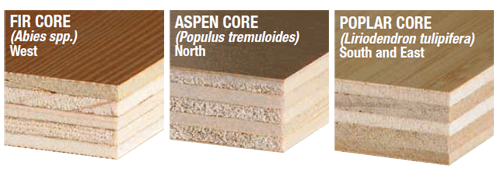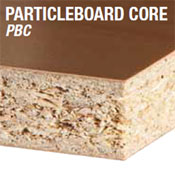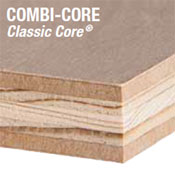The Heart of any Panel: Which Core is Best?
- January 1, 2016
- •
- by Ang Schramm
Hardwood plywood is sold primarily for its aesthetics…we all know that! Since in reality we observe wood surfaces in 2 dimensions only, we typically don’t spend a lot of time wondering what’s underneath the beautiful, high quality, exquisitely finished maple, birch, alder, cherry, walnut, or oak face. Our first thought when we see a piece of fine furniture or a beautiful set of newly installed kitchen cabinets is, “wow!”
Ok…all we see is the “wow,” part, but what’s under the surface is quite important, and is usually the subject of much pondering and consideration. In developing a product such as a cabinet or dining table, a designer must first consider his or her choice for the surface that will appeal to the observer. Their second consideration, while not a visible aspect of the finished product, is, however, very important. He or she must ask the question I have constantly been asked for more than 45 years: “What is the best substrate (core) to use?”
I have jokingly stated that the answer to that question is predictably the same as the answer to the question, “what do you give your 105 year old uncle for his birthday? The answer: “Depends!” Sorry about that…
There are 4 core types available to all plywood manufacturers, and, as I indicated in our WoodWorks® Newsletter Volume V in September, 2009, each has its own set of physical properties and engineering qualities that collectively should provide the designer with ample information to determine the best core material for their particular project.
The core types are briefly discussed below as only a refresher for most readers who are very familiar with the products:
- Veneer Core (VC)
Veneer core is the oldest core material, probably born in a fledgling structural plywood mill back in the early 20th century when someone realized they could make a structural panel, but put a thick piece of rotary decorative hardwood like birch or oak on the outside of the panel and thus create a new market for their company. Veneer core is exceptionally strong as it is not only un-processed wood other than the fact it was peeled rather than sawn from a log, but also stronger due to the way the individual components are reassembled to make the finished panel. Because wood is an anisotropic material, that is, it has differing properties in different directions, the 90o grain orientation of every other component in the “sandwich” means the panel core has a higher strength value in both width and length. It has very high engineering properties including MOR, MOE, and Screw Extraction Resistance (See table in Volume V referenced above). It is reasonably lightweight, machines well, and is quite stable under controlled in-service conditions. On the downside, most veneer lathes have limited ability in maintaining a uniform thickness across the width and along the length of the core components, thus, when multiplied by the number of plies in the finished product, there will almost always be some thickness variation. With the acquisition of modern Meinan lathe technology with the capability to hold a thickness tolerance within a very close range, Columbia Forest Products has been able to reduce the wild swings in thickness more common with the older technology. Because the rotary cutting process generates a traumatic contact between the lathe knife and the wood surface, some surface roughness is to be expected in veneer core. Again, the Columbia Forest Products’ Meinan lathes do a remarkable job in leaving a smooth surface, thus alleviating quite a bit of the typical roughness that can be quite common in a veneer core panel.

- Engineered Core
 For our purposes, this term usually refers to either particleboard (PBC) or medium density fiberboard (MDF). These products are manufactured by outside sources for most manufacturers using either finely ground wood particles or processed wood fibers to produce a board that is rigid, smooth, and uniform in thickness. In the case of MDF, the edges of most production may even be profiled and finished if so doing meets a designer’s needs. Because of these attributes, applications requiring very stringent specifications for thickness and surface quality are best served by one of these two products. On the downside, PBC and MDF are both quite heavy, and while having respectable physical properties and overall strength, they are not as strong as veneer core.
For our purposes, this term usually refers to either particleboard (PBC) or medium density fiberboard (MDF). These products are manufactured by outside sources for most manufacturers using either finely ground wood particles or processed wood fibers to produce a board that is rigid, smooth, and uniform in thickness. In the case of MDF, the edges of most production may even be profiled and finished if so doing meets a designer’s needs. Because of these attributes, applications requiring very stringent specifications for thickness and surface quality are best served by one of these two products. On the downside, PBC and MDF are both quite heavy, and while having respectable physical properties and overall strength, they are not as strong as veneer core.
- Combination Core

Combination core, or combi-core as it is sometimes called, is, as the name infers, a pre-assembled or line by line construction of core and face and back utilizing a very thin layer of engineered core as the outer ply (cross band)of a core construction that has veneer components as the remainder of the sandwich. Columbia’s Classic core falls into this category, and is highly desirable where both smoothness and strength are critical. The trade-off is that it is still not quite as strong as veneer core, and it is can be subject to thickness fluctuations.
- Lumber Core
Lumber core was once the king of substrate materials. Born of a need created in the piano industry as far back as the mid-1800s, this product allowed for solid lumber from high quality structural production of a lesser appealing species like basswood or tulipwood (yellow poplar) as a uniformly thick, and very smooth surface for the 1/10” highly prized re-sawn faces of mahogany or walnut. In today’s environment, most of the lumber core is either of such low quality that it fails to meet the requirements of ANSI/HPVA HP-1-2009, 3.7.1-3 Standard Grades. That material that does meet the standard is often as expensive or even more costly than using solid wood of the surface species. In that light, lumber core is largely unimportant
In conclusion, I hope I have demonstrated the applicability of each of the core types, and created a better understanding of the answer to the question, “which core is better?” As I so crudely indicated above (with apologies at this time), the answers is always, “Depends!”
Hope you have all had a wonderful celebration of the season and that you will all have a fruitful and enjoyable 2016!
Ang




